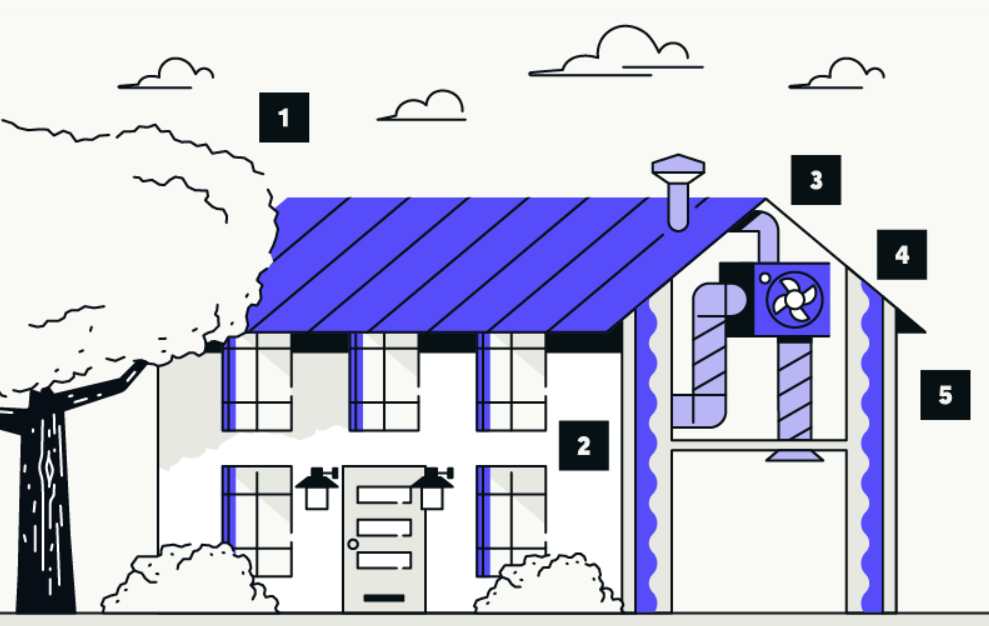Let's face it: air conditioning can be a life saver, especially for those who live in climates that get extremely hot or cold. However, it uses an immense amount of energy that is not only bad for the environment but for your wallet.
People have started coming up with innovative living solutions to combat climate change such as earthships and urban homesteading, but have you heard of a passive house? A passive house uses innovative construction and technology to not only keep your home at a comfortable temperature, but lower your electric bill.
What is a passive house?
A passive house is a structure which can control its own climate and maintain its temperature without an active heating or cooling system. It was created by the Passivhaus Institut in Germany which was founded back in 1996. They are among the most energy efficient and eco-friendly homes as it uses its environment to sustain its own climate.
Passives homes heat and cool themselves by utilizing shade, sunlight and other internal and external factors that affect temperature. As a result, it saves up to 90% of energy compared to typical buildings and 75% compared to newly-constructed buildings—eliminating the need for the traditional air conditioning.
Free heating and cooling can come from many different sources. Free heat can come from things like sunlight, body temperature, gas, ovens and lightbulbs. Alternatively, shade is used to keep a house cool during warmer seasons.
Heated air inside the building often escapes through cracks, insufficient windows or poor insulation. To seal in the desired amount of heat, insulation is wrapped around the entire building and triple-paned windows are installed to ensure an airtight enclosure. Additionally, a high-performing ventilation system exchanges humid air and contaminants with fresh air from outdoors to help maintain the temperature and quality of the air inside.
What are the benefits of passive home design?
Passive homes are very environmentally friendly due to the fact that they are extremely energy-efficient. However, there are plenty more benefits to a passive home than just the environment.
Reduced cost: One of the most appealing benefits of investing in a passive house is the lower energy cost. By saving up to 90% of energy compared to most typical buildings today, it means less money goes to your electric bill.
Improved air quality: Another great benefit to a passive house is the improved indoor air quality. The high quality ventilation system filters out dust, pollen and other pollutants in the air keeping the air in your home fresh. The airtight seal helps keep the fresh air in while pollutants and odors stay out.
Increased comfort: A passive home helps increase the comfort of its occupants by maintaining a steady and comfortable temperature throughout the house. Since the windows and doors are well insulated, those parts of the house remain consistent with the rest of the house. Not only that, but the unique ventilation system results in a quieter home compared to standard air conditioning units.
DIY tips to save energy at home
You don’t have to build a passive house to start saving energy today. In fact, small changes and habits can make a big difference on your electricity bill and our planet each month. Here are some DIY tips for saving energy at home.
- Ditch the hot water when running the laundry: Did you know that most of the energy generated during laundry is used to heat the water? You can cut back on energy by running cold water loads instead, or saving heated loads for intimates and bed sheets only.
- Upgrade to energy-efficient bulbs and appliances: When you need a new bulb or appliance, purchase an energy-efficient replacement to save big on your electric bill. Compact fluorescent (CFL) bulbs use 70–90% less energy than regular bulbs and can save anywhere from $30-80 on your energy bill over the bulb’s lifetime. When it comes to new appliances, look for Energy Star ratings to ensure they’ll save you money on operating costs (you may also get a rebate for purchasing too).
- Embrace natural light: Using natural light in your home isn’t just good for the environment, it’s good for you too. Bring positive energy and Vitamin D to your space by arranging furniture near windows and using mirrors to reflect natural light throughout the home. You can also use the heat from the sun to warm your home by opening shades on the southern and eastern windows during the day and then closing the shades at night.
- Draw the blinds in the summer: In the summer, sunshine in the home can turn your home into a sauna. To keep your home cool, draw your blinds in the summer months.
- Insulate your attic: In order to be energy-efficient, your home’s attic must be insulated to prevent heat loss in the winter and retain cool air in the summer. This one DIY project can reduce heating and cooling needs by 30%! This weekend project isn’t for the faint of heart, though: it requires upfront costs, patience, research and hard work.
- Use ceiling fans appropriately: Installing ceiling fans is a great way to keep your house cool. Fans help circulate the air conditioning you are running, so run them counterclockwise in the summer to push air straight down and create a chilling effect. In the winter, clockwise fans will slowly force warm air down. You’ll also want to clean them regularly to keep them running optimally and free of dust.
Final thoughts
Needless to say, energy-inefficient heating and cooling systems are a thing of the past. If you plan on building your own home or remodeling, consider investing in a passive house system so you can reap the benefits of a healthier home and environment while eventually saving a lot of money. For more information on passive homes, check out The Zebra’s infographic below!

For more sustainable tips, be sure to sign up for NatureHub! 😉


